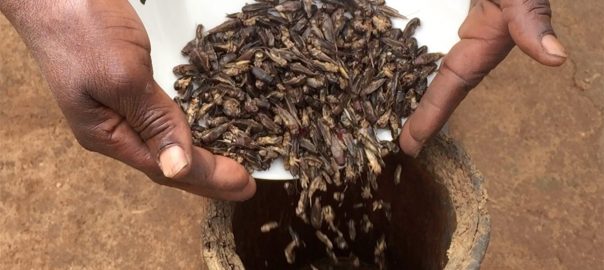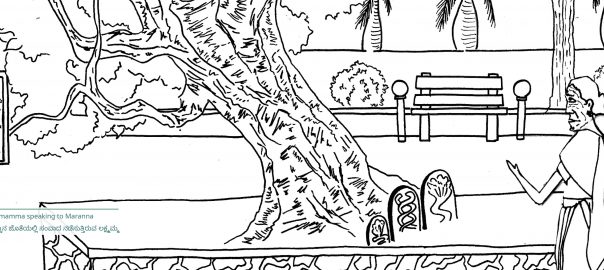“Yet these you may eat among all the winged insects which walk on all fours: those which have above their feet jointed legs with which to jump on the earth.”
—Leviticus 11:21
Masaka
On a recent trip to the town of Masaka, Uganda, I met a number of women who have taken up cricket farming to supplement their family diets and generate extra income. “It has improved the health of our children… it’s not very tiresome… but you get a lot of money from it”, explained Damali Mayito, a full-time school teacher and mother of three. She unbolted her garage doors, which swung open to reveal towers of plastic boxes chirping from within: was this the sound of a simple solution to a suite of complex social and ecological problems?

Everyone’s at it
The nutritional benefits of entomophagy are well-documented: edible insects offer a low-fat protein source packed full of vitamins, minerals, and fibre. Globally, around 2 billion people regularly eat insects, primarily in the developing world.
The most experimental cultures—those most likely to adopt unfamiliar culinary practices, such as entomophagy—flourish in cities.
Almost everyone else does so unintentionally—from pasta to peanut butter, virtually all processed foods contain traces of the interlopers. At least 470 insect species are eaten in Africa. These include locusts, grasshoppers, crickets, shield bugs, ants, bees, beetles, termites, and caterpillars.

Entomoculture trumps wild-harvesting
Entomophagy may be as old as humankind, but the practice of farming insects for human consumption is a relatively new phenomenon. Only a few countries, mainly in Asia, have established thriving entomoculture sectors. In Thailand, there are over 20,000 registered entomoculture enterprises, while in the USA and Canada, several dozen entoculture startups are now finding their feet. Compared to the wild-harvesting of insects, entomoculture offers four key advantages:
| Farmed insects | Wild-harvested insects | |
| Availability | Year round supply. | Usually only seasonally abundant. |
| Quality | Ability to control the quality of insect feed. | Wild populations may have fed unscrupulously on crops soaked in pesticide. Fearing toxic bioaccumulation, Malian villagers are known to discourage children from harvesting wild grasshoppers. |
| Ecological impact | Minimal interference with natural ecosystems. | Wild-harvesting may lead to population declines in target species (e.g. mopane worms) and accrue significant by-catch, especially when indiscriminate electric light traps are used. |
| Safety | Generally non-hazardous. | Wild-harvesting techniques can be dangerous. Foragers may be at risk of attack by wild animals, while makeshift electric light traps are notorious for causing electrocution and blindness.. |
Crickets for cities
Over the last few years, the Dutch-funded Flying Food Project has trained hundreds of East African women to produce “nutritious crickets for delicious food security”. They rear common house crickets (Acheta domestica), which are ideal for farming, especially in urban settings.
- Under good conditions, crickets reach maturity after just 35 days and then reproduce rapidly: each female lays up to 2600 eggs in its 90 day lifespan.
- Owing to their high feed-conversion ratio, crickets require as little as one-twelfth the feed of cattle and very little water.
- They are unfussy eaters: vegetal food waste otherwise destined for the bin will suffice, as will garden foliage or chicken feed.
- On a fresh weight basis, crickets comprise up to 25 percent protein—rivalling beef, pork, lamb, chicken, and seafood.
- They have low environmental impacts: per unit of mass gained, crickets emit 300 times less greenhouse gas than cattle.
- They are extremely space efficient and can be farmed in boxes, piled vertically.
- They require minimal management—a couple of hours’ labour per week is all that is required to manage thousands of crickets.
- They are safe to farm: crickets do not bite, nor do they seem to pass zoonotic diseases to people. There’s no such thing as mad cricket disease!
Many of these advantages lend themselves well to cities, where busy, cash-strapped people with poor diets and limited physical space abound. It is in cities where people are hardest-pressed to recycle their food waste and, arguably, it is in cities where people are most acutely aware of the need to reduce ecological footprints and reclaim food sovereignty. More importantly, it is in cities, where the most daring, open-minded, and experimental cultures flourish: those most likely to challenge societal norms and adopt new culinary practices.


Start your own cricket farm
Do you want to hop on the bandwagon and grow your own easy-peasy, eco-friendly superfood? Entomoculture is simple. Follow these 5 basic steps, which I jotted down in Uganda.
- Lay the groundwork
Find a large plastic box with a lid and cut out some holes to form air vents. Glue fine mesh over the vents. Place some empty cardboard egg boxes and a shallow dish of water into the plastic box.
- Find your founders
It is possible to purchase crickets online from pet stores or, if you have time, to capture them from the wild. To minimise inbreeding, it is recommended you start with 20 crickets—at least 1 male for every 5 females. The females can be distinguished by their long ovipositors and the males by their rough backs. Put the crickets inside the plastic box and feed them on vegetable matter or chicken meal. For best results, an ambient temperature of 23 to 30 degrees Celsius should be maintained. The initial batch of crickets should be used for breeding only as they are unlikely to have been reared for human consumption.
- Let them love and lay
Place a small tray of clean moist topsoil into the plastic box with the crickets. Spray water onto the soil everyday to maintain moisture levels. Eventually little white eggs should appear in the topsoil. Remove the egg-laden tray from the plastic box and place it in a separate plastic box of similar dimensions. The eggs should hatch after 10 days. Note that separation from adults is essential to prevent cannibalism.
- Reap a harvest
The 2nd generation of crickets should be reared in the same manner as their parents. They should reach full size after 1 or 2 months depending on the optimality of conditions. It is at this point, before reaching sexual maturity, that they should be harvested. Spare plenty of females for breeding, at least five for every male. Those spared should reach sexual maturity a few weeks later. A clear indicator of sexual maturity is when they grow wings and begin chirping.
- Salivate and savour
The harvested crickets should be boiled for a few minutes to kill any bacteria lurking on their exoskeletons. They can then be fried, roasted, or dried and ground into a fine powder. The latter option is popular as the powder can be easily stored and subtly added to baked goods, porridge or health-shakes. The Internet is awash with imaginative cricket recipes!
While in Uganda, my colleague, Steven Bland and I shot a short film capturing our experiences. Let us know what you think: Are you ready to embrace entomophagy?
Russell Galt
Cape Town
Further reading:
Kelemu, S., Niassy, S., Torto, B., Fiaboe, K., Affognon, H., Tonnang, H., Maniania, N.K. and Ekesi, P., 2015. African edible insects for food and feed: inventory, diversity, commonalities and contribution to food security. Insects as Food and Feed, 1(2): 103-119
Van Huis, A., 2003. Insects as food in Sub-Saharan Africa. Insect Science and its Application 23: 163-185
Van Huis, A., Van Itterbeeck, J., Klunder, H., Mertens, E., Halloran, A., Muir, G. and Vantomme, P., 2013. Edible insects: future prospects for food and feed security. FAO Forestry Paper 171. FAO, Rome, Italy.







Leave a Reply